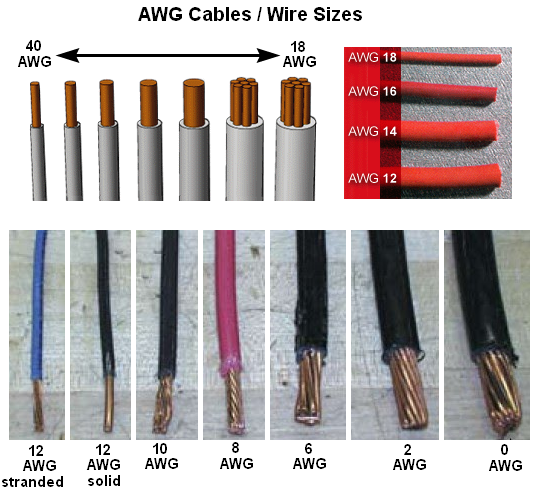Wire gauge: Difference between revisions
J.williams (talk | contribs) No edit summary |
J.williams (talk | contribs) m (1 revision imported) |
(No difference)
| |
Revision as of 21:31, 26 August 2015

Wire gauge is the measure of how large of a cross section a wire has. Knowing the gauge is important because it tells us how much current a wire can carry without being damaged (this quantity is called ampacity.
American wire gauge system
The American Wire Gauge system (AWG) allows for standard wire sizes (determined by cross sectional area) to be identified and assigns them an AWG number. A lower gauge wire has a larger diameter and thus is able to carry higher currents. There are a total of 40 different gauge sizes with cross secitonal areas ranging from 0.013 mm2 to 107.22 mm2 with their diameters changing incrementally between each gauge number.
| AWG number | Cross sectional area (mm2) | Ohms/km (/km) | Ampacity (A) | Usage example |
|---|---|---|---|---|
| 18 | 0.82 | 20.95 | 14 | Low voltage lighting |
| 16 | 1.31 | 13.18 | 18 | Extension cords |
| 14 | 2.08 | 8.28 | 25 | Lighting fixtures |
| 12 | 3.31 | 5.21 | 30 | Kitchen appliances |
| 10 | 5.26 | 3.28 | 40 | Electric dryers |
| 8 | 8.37 | 2.06 | 55 | Electric ovens |
| 6 | 13.30 | 1.30 | 75 | Large electric heaters |
| 4 | 21.15 | 0.81 | 85 | Large furnaces |
| 3 | 26.67 | 0.65 | 115 | Large commercial wiring |
| 2 | 33.63 | 0.51 | 130 | Car battery cable |
| 1 | 42.41 | 0.41 | 145 | Power distribution |
| 1/0 | 53.47 | 0.32 | 170 | Power distribution |
| 2/0 | 67.43 | 0.26 | 195 | Power distribution |
| 3/0 | 85.03 | 0.20 | 225 | Power distribution |
| 4/0 | 107.22 | 0.16 | 260 | Power distribution |
| 250 | 126.68 | 0.13 | 290 | Power distribution |
| 350 | 177.35 | 0.10 | 350 | Power distribution |
| 400 | 202.68 | 0.08 | 380 | Power distribution |
The figures above are taken from Table 310.15(B)(16) in the 2014 National Electrical Code (USA) and assume a temperature rating of 90°C[2]. Also, Table 3.1 on page 69 in Introduction to Electricity was used as a template/reference.[3]
For a more complete list, please see Dr. Rowlett's unit page.
References
- ↑ internet: http://en.docsity.com/news/university-admission-tests/10-online-free-tools-to-help-college-university-studies/
- ↑ "2014 National Electrical Code" Table 310.15(B)(16)
- ↑ "Introduction to electricity" Pearson: Robert T. Paynter, B.J Toby Boydell

